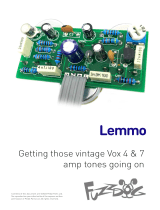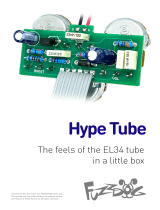Page is loading ...

3-Band Rat
Rat with a Marshall-type
3 band EQ
Contents of this document are ©2021 Pedal Parts Ltd.
No reproduction permitted without the express written
permission of Pedal Parts Ltd. All rights reserved.

Important notes
If you’re using any of our footswitch daughterboards,
DOWNLOAD THE DAUGHTERBOARD DOCUMENT
•Download and read the appropriate build document for the daughterboard
as well as this one BEFORE you start.
•DO NOT solder the supplied Current Limiting Resistor (CLR) to the main
circuit board even if there is a place for it. This should be soldered to the
footswitch daughterboard.
POWER SUPPLY
Unless otherwise stated in this document this circuit is designed to be
powered with 9V DC.
COMPONENT SPECS
Unless otherwise stated in this document:
•Resistors should be 0.25W. You can use those with higher ratings but
check the physical size of them.
•Electrolytics caps should be at least 25V for 9V circuits, 35V for 18V
circuits. Again, check physical size if using higher ratings.
LAYOUT CONVENTIONS
Unless otherwise stated in this document, the following are used:
•Electrolytic capacitors:
Long leg (anode) to square pad.
•Diodes/LEDs:
Striped leg (cathode) to square pad. Short leg to square pad for LEDs.
•ICs:
Square pad indicates pin 1.

Schematic + BOM
R1 1M
R2 1K
R3 560R
R4 1K
R5 33K
R6 1M
R7 10K
R8 10K
R9 10K
R10 1K5
R11 1M
C1 22n
C2 1n
C3 100p
C4 33p
C5 4u7 elec
C6 2u2 elec
C7 4u7 elec
C8 470p
C9 22n
C10 1u elec
C11 100u elec
C12 47u elec
C13 47n
C14 4u7 elec
C15 22n
C16 100p
C17 22n
D1 1N4001
D2-3 1N4148
D4-5* 3mm Red LED
D6* Jumper
IC1 LM308 / OP07
Q1** 2N5457
VOL 100KA
DIST 100KA
BASS 1MA
MID 25KA
TREB 250KA
RUEZ 1K TRIM
S1* SPDT ON-ON
*S1 and D4-5 are optional alternative clipping. If you prefer to keep it standard just
leave those out and add a jumper on S1 as shown on page 5. We’ve also added an
extra spot, D6, so you can experiment with asymetrical clipping if you like. Use
1N4148 in here if you want to try it.
**You can use through-hole or SMT parts (MMBF5457) for Q1.


The power and signal pads on the PCB conform
to the FuzzDog Direct Connection format, so can
be paired with the appropriate daughterboard for
quick and easy offboard wiring. Check the
separate daughterboard document for details.
Be very careful when soldering the transistor,
diodes and LED. They’re very sensitive to heat.
You should use some kind of heat sink (crocodile
clip or reverse action tweezers) on each leg as
you solder them. Keep exposure to heat to a
minimum (under 2 seconds).
Snap the small metal tag off the pots so they can
be mounted flush in the box.
You should solder all other board-mounted
components before you solder the pots. Once
they’re in place you’ll have no access to much of
the board. Make sure your pots all line up nicely.
The best way to do that is to solder
a single pin of each pot in place then melt and
adjust if necessary before soldering in the other
two pins. If your pots don’t have protective
plastic jackets ensure you leave a decent gap
between the pot body and the PCB otherwise
you risk shorting out the circuit.
If you’re not adding the extra clipping in positions
D4 and D5, add a jumper wire on S1 as shown in
red above.
A jumper is required in D6 if you aren’t adding an
extra diode for asymetrical clipping.
PCB layout ©2021 Pedal Parts Ltd.

Extra notes....
No Ruez mod please
Replace the 1K Ruez trimmer with a 47R resistor
if you want to keep things stock.
You’ll need to place it vertically into these pads >>>>
Tone stack tweaking
No rules here. Google is your friend.
The values in the BOM are taken from the Krank
Distortus Maximus and work very well. A boutique
variation of that circuit, the ProTone Body Rot, uses
the following values:
BASS 50KA
MID 2KB
TREB 25KB
R5 2K2
C8 4n7
C15 330n
C17 330n

Test the board!
Check the relevant daughterboard document for more
info before you undertake this stage.
UNDER NO CIRCUMSTANCES will troubleshooting help
be offered if you have skipped this stage. No exceptions.
Once you’ve finished the circuit it makes sense to test is before starting on the switch and LED
wiring. It’ll cut down troubleshooting time in the long run. If the circuit works at this stage, but it
doesn’t once you wire up the switch - guess what? You’ve probably made a mistake with the switch.
Solder some nice, long lengths of wire to the board connections for 9V, GND, IN and OUT. Connect
IN and OUT to the jacks as shown. Connect all the GNDs together (twist them up and add a small
amount of solder to tack it). Connect the battery + lead to the 9V wire, same method. Plug in. Go!
If you’re using a ribbon cable you can tack the wires to the ends of that. It’s a lot easier to take them
off there than it is do desolder wires from the PCB pads.
If it works, carry on and do your switch wiring. If not... aw man. At least you know the problem is
with the circuit. Find out why, get it working, THEN worry about the switch etc.
Your completed circuit board
including pots

Wiring shown above will disconnect the battery when you remove the jack plug
from the input, and also when a DC plug is inserted.
The Board GND connections don’t all have to directly attach to the board. You
can run a couple of wires from the DC connector, one to the board, another to
the IN jack, then daisy chain that over to the OUT jack.
It doesn’t matter how they all connect, as long as they do.
This circuit is standard, Negative GND. Your power supply should be Tip
Negative / Sleeve Positive. That’s the same as your standard pedals (Boss etc),
and you can safely daisy-chain your supply to this pedal.
L
E
D
BOARD
OUT
BOARD
9V
BOARD
GND
BOARD
GND
BOARD
GND
BOARD
INPUT
BATTERY
+
IN
OUT
L
E
D
BOARD
GND
BOARD
9V
+
Wire it up (if using a daughterboard please refer to the relevant document)

This template is a rough guide only. You should ensure correct marking of your
enclosure before drilling. You use this template at your own risk.
Pedal Parts Ltd can accept no responsibility for incorrect drilling of enclosures.
FuzzDog.co.uk
Drilling template
Hammond 1590B
60 x 111 x 31mm
It’s a good idea to drill the pot and
toggle switch holes 1mm bigger if
you’re board-mounting them.
Wiggle room = good!
Recommended drill sizes:
Pots 7mm
Jacks 10mm
Footswitch 12mm
DC Socket 12mm
Toggle switches 6mm
35mm
27mm
/














